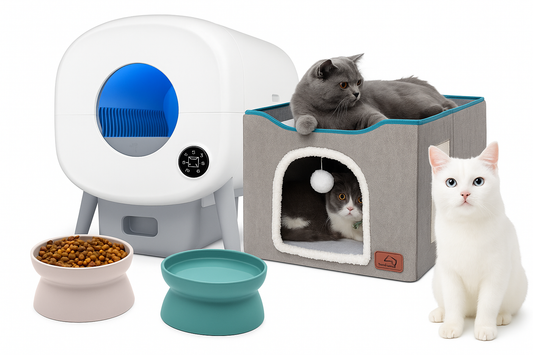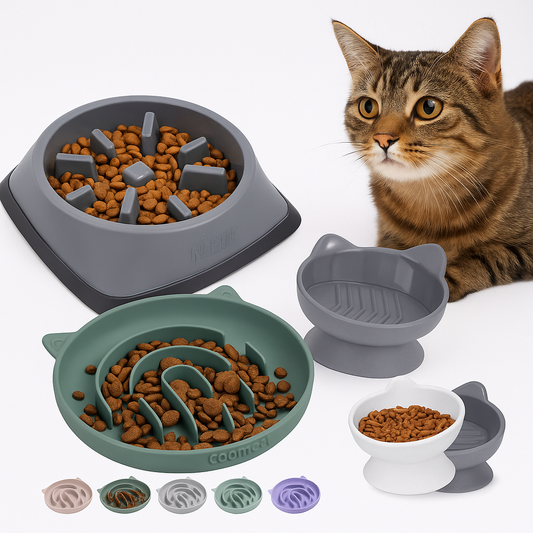
Ceramic vs Stainless Steel Cat Bowls: What’s Better?
When it comes to feeding your feline friend, choosing the right bowl may seem like a minor decision — but it can actually have a significant impact on your cat’s health, happiness, and hygiene. With so many options available, pet parents are often torn between ceramic and stainless steel cat bowls. Each type has its own benefits and drawbacks, and knowing which is best for your cat can help improve their feeding experience. In this post, we’ll break down the pros and cons of ceramic and stainless cat bowls, explore why bowl choice matters, and offer some of the best food bowl options available today. Whether you’re upgrading your cat’s mealtime setup or choosing a bowl for the first time, this guide has you covered.
Why the Right Cat Bowl Matters More Than You Think
Cats are creatures of habit and comfort. While they may not be able to tell you with words, the type of food bowl they use can influence how much they eat, how often they eat, and even how they feel during meals. So, why exactly is bowl material such a big deal?
1. Hygiene & Safety: Stainless steel bowls are known for being hygienic and bacteria-resistant. They’re less porous than ceramic, which means they’re less likely to hold on to germs. However, ceramic bowls can be safe too—as long as they’re made from high-quality, lead-free materials and glazed properly. Cheap ceramic bowls can chip or crack, harboring bacteria in the damaged areas.
2. Whisker Fatigue: Many cats experience “whisker fatigue,” a sensitivity caused by their whiskers constantly touching the sides of deep or narrow bowls. Both stainless steel and ceramic bowls come in shallow, wide designs that reduce this discomfort.
3. Durability: Stainless steel bowls are lightweight, virtually indestructible, and dishwasher safe. On the other hand, ceramic bowls are heavier and more stable—less likely to slide around while your cat eats. But they can break if dropped.
4. Aesthetics: If style is a big factor for you, ceramic bowls often come in beautiful colors and designs that blend into your home décor better than utilitarian stainless steel ones.
5. Price & Value: Ceramic bowls tend to cost a bit more, especially for decorative or elevated models. Stainless steel bowls are usually more affordable and long-lasting—making them a good option for budget-conscious pet owners.
Ultimately, the best food bowl comes down to your cat’s unique needs and preferences—along with your lifestyle and cleaning routine. Let’s dive into some great options for both ceramic and stainless steel cat bowls.
Top Ceramic and Stainless Steel Cat Bowls Compared
Final Thoughts: Which Cat Bowl Is Right for You?
Both ceramic and stainless steel cat bowls have their merits—and the choice really depends on your cat’s needs and your lifestyle. If you prioritize easy cleaning and long-term durability, stainless steel is a smart, hygienic option. If you prefer a bowl that complements your décor and provides a heavier, tip-proof feel, then ceramic may be the better choice. Keep in mind factors like your cat’s age, face shape, and eating habits. And no matter which material you choose, make sure it’s a bowl designed with your pet’s comfort in mind—especially when it comes to whisker fatigue and height. With the options above, you're bound to find the best food bowl for your furry friend.
Looking for more pet gear reviews or cat care tips? Check out our other blog posts to keep your cat happy, healthy, and well-fed!
Related Articles
- Best Slow Feeder Cat Bowls: Prevent Gulping and Keep Your Cat from Vomiting
- Top Best Cat Water Fountains: Keep Your Kitty Hydrated with These 5 Picks
- Top 5 Automatic Cat Feeders for Hassle-Free Mealtimes
- Feline Enrichment Series, Part 3: Puzzle Feeders and Treat Dispensers for a Smarter Mealtime
- Ceramic vs Stainless Steel Cat Bowls: What’s Better?
Affiliate Disclosure: Some of the links in this article may be affiliate links. This means if you click and make a purchase, we may earn a small commission—at no extra cost to you. As a participant in the Amazon Associates program, Capnip earns from qualifying purchases.













